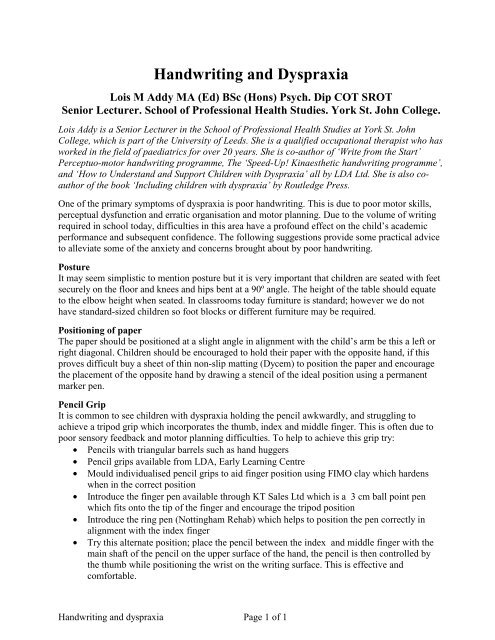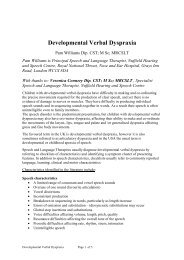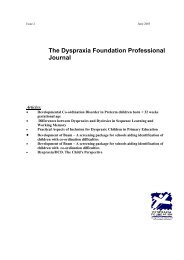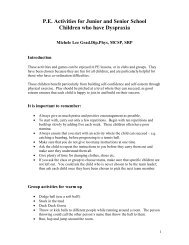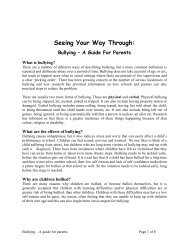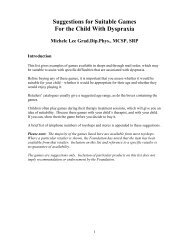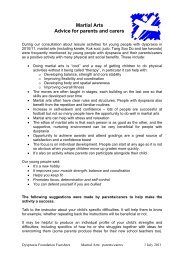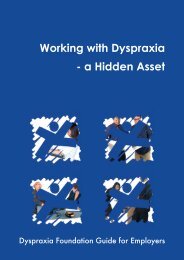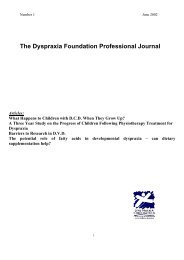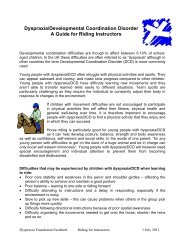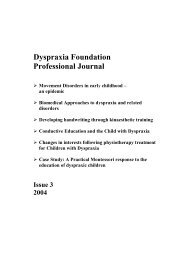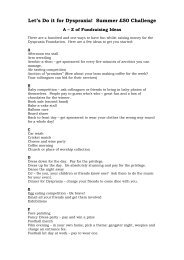Handwriting and Dyspraxia - Dyspraxia Foundation
Handwriting and Dyspraxia - Dyspraxia Foundation
Handwriting and Dyspraxia - Dyspraxia Foundation
Create successful ePaper yourself
Turn your PDF publications into a flip-book with our unique Google optimized e-Paper software.
<strong>H<strong>and</strong>writing</strong> <strong>and</strong> <strong>Dyspraxia</strong><br />
Lois M Addy MA (Ed) BSc (Hons) Psych. Dip COT SROT<br />
Senior Lecturer. School of Professional Health Studies. York St. John College.<br />
Lois Addy is a Senior Lecturer in the School of Professional Health Studies at York St. John<br />
College, which is part of the University of Leeds. She is a qualified occupational therapist who has<br />
worked in the field of paediatrics for over 20 years. She is co-author of ‘Write from the Start’<br />
Perceptuo-motor h<strong>and</strong>writing programme, The ‘Speed-Up! Kinaesthetic h<strong>and</strong>writing programme’,<br />
<strong>and</strong> ‘How to Underst<strong>and</strong> <strong>and</strong> Support Children with <strong>Dyspraxia</strong>’ all by LDA Ltd. She is also coauthor<br />
of the book ‘Including children with dyspraxia’ by Routledge Press.<br />
One of the primary symptoms of dyspraxia is poor h<strong>and</strong>writing. This is due to poor motor skills,<br />
perceptual dysfunction <strong>and</strong> erratic organisation <strong>and</strong> motor planning. Due to the volume of writing<br />
required in school today, difficulties in this area have a profound effect on the child’s academic<br />
performance <strong>and</strong> subsequent confidence. The following suggestions provide some practical advice<br />
to alleviate some of the anxiety <strong>and</strong> concerns brought about by poor h<strong>and</strong>writing.<br />
Posture<br />
It may seem simplistic to mention posture but it is very important that children are seated with feet<br />
securely on the floor <strong>and</strong> knees <strong>and</strong> hips bent at a 90º angle. The height of the table should equate<br />
to the elbow height when seated. In classrooms today furniture is st<strong>and</strong>ard; however we do not<br />
have st<strong>and</strong>ard-sized children so foot blocks or different furniture may be required.<br />
Positioning of paper<br />
The paper should be positioned at a slight angle in alignment with the child’s arm be this a left or<br />
right diagonal. Children should be encouraged to hold their paper with the opposite h<strong>and</strong>, if this<br />
proves difficult buy a sheet of thin non-slip matting (Dycem) to position the paper <strong>and</strong> encourage<br />
the placement of the opposite h<strong>and</strong> by drawing a stencil of the ideal position using a permanent<br />
marker pen.<br />
Pencil Grip<br />
It is common to see children with dyspraxia holding the pencil awkwardly, <strong>and</strong> struggling to<br />
achieve a tripod grip which incorporates the thumb, index <strong>and</strong> middle finger. This is often due to<br />
poor sensory feedback <strong>and</strong> motor planning difficulties. To help to achieve this grip try:<br />
• Pencils with triangular barrels such as h<strong>and</strong> huggers<br />
• Pencil grips available from LDA, Early Learning Centre<br />
• Mould individualised pencil grips to aid finger position using FIMO clay which hardens<br />
when in the correct position<br />
• Introduce the finger pen available through KT Sales Ltd which is a 3 cm ball point pen<br />
which fits onto the tip of the finger <strong>and</strong> encourage the tripod position<br />
• Introduce the ring pen (Nottingham Rehab) which helps to position the pen correctly in<br />
alignment with the index finger<br />
• Try this alternate position; place the pencil between the index <strong>and</strong> middle finger with the<br />
main shaft of the pencil on the upper surface of the h<strong>and</strong>, the pencil is then controlled by<br />
the thumb while positioning the wrist on the writing surface. This is effective <strong>and</strong><br />
comfortable.<br />
<strong>H<strong>and</strong>writing</strong> <strong>and</strong> dyspraxia Page 1 of 1
Heavy Pressure<br />
Heavy pressure through the writing instrument can slow writing output significantly. We know<br />
that many children with dyspraxia struggle to monitor pressure through their limbs due to what is<br />
termed poor proprioception, therefore we need to help the child to develop an awareness of the<br />
amount of pressure placed through the limbs, the upper limbs in particular.<br />
The following will help:<br />
• Regularly undertake a series of exercises whereby pressure is placed through the upper<br />
limbs, i.e. crawling games, wheelbarrows, ladies press-ups, elephant walks etc. These<br />
should ideally be incorporated into a daily schedule<br />
• Provide a light-up pen which can be bought cheaply from stationary shops. Challenge the<br />
child to write so that the light does not come on.<br />
• Play a game of MI5; provide a pad created by placing a layer of paper alternately with<br />
carbon paper. Ask the child to write a secret message so that only one agent can read it.<br />
Initially the pressure may make the child write so that the message can be seen on 3 or 4<br />
copies but by encouraging the child to self-monitor pressure will reduce.<br />
• Use a hard leaded pencil such as HB so that writing is not easily smudged.<br />
Light Pressure<br />
Some children with dyspraxia will have the opposite problem to that described above in that they<br />
will not apply enough pressure through the writing instrument. This will affect control <strong>and</strong> will<br />
make writing appear ‘spidery’ <strong>and</strong> poorly formed. To help with this:<br />
• Provide an angled board. The angle should be approximately 25º this will ensure that the<br />
wrists are positioned on the writing surface.<br />
• Provide weighted wrist-b<strong>and</strong>s which would provide additional sensory feedback to the<br />
wrist area, increasing the child’s awareness of their h<strong>and</strong>, wrist <strong>and</strong> arm position.<br />
• Lower the table slightly so that the hips are flexed more than 90 . This enables the child to<br />
obtain the assistance of body weight to assists with pressure through the writing instrument.<br />
• Use softer leaded pencils such as 2B so writing appears darker<br />
Fine Motor Control<br />
The combination of poor sensation, inadequate tactile sensation <strong>and</strong> poor pressure awareness will<br />
result in poor motor control <strong>and</strong> the child may need to practice simple motor tasks to develop an<br />
ability to track <strong>and</strong> scan ahead<br />
To develop this:<br />
• Introduce puzzles such as mazes; grade these in complexity<br />
• Use electronic tracker games where a buzzer sounds if the wire is touched, these usually<br />
come with 3 levels of difficulty<br />
• Use dot to dot puzzles<br />
• Button <strong>and</strong> bead threading games<br />
• Cutting out complex outlines with scissors<br />
• Pattern making using geoboards<br />
• Construction activities such as Lego <strong>and</strong> Knex<br />
• Encourage creative activities such as collage, papier mache.<br />
Writing alignment<br />
As many children with dyspraxia struggle to plan <strong>and</strong> organise their movements, they will also<br />
find writing across the page in a left to right horizontal direction very difficult. Guidance is<br />
therefore needed to help them with writing alignment:<br />
• Always use lined paper rather than a line guide which easily moves.<br />
<strong>H<strong>and</strong>writing</strong> <strong>and</strong> dyspraxia Page 2 of 2
• Mark a margin at the left h<strong>and</strong> side in a clear colour or place starting points at the left<br />
margin to reiterate where each line of writing should start.<br />
• Create coloured lines on plain or pastel coloured paper encouraging the child to write on a<br />
different colour each line (this can be done easily using a computer with colour printer)<br />
• If a child has significant difficulties in this area, created coloured b<strong>and</strong>s across the paper<br />
(rather than lines) encouraging the child to write within each b<strong>and</strong> before proceeding to the<br />
next.<br />
• Provide ‘Right line’ or ‘hint-print’ paper which incorporate lines which are slightly raised<br />
giving a tactile reference when writing each letter.<br />
Letter Formation<br />
It may seem incomprehensible why children with dyspraxia cannot seem to reproduce familiar<br />
letter shapes <strong>and</strong> forms even when these are placed directly in front of them. This is due to poor<br />
form constancy, a vital perceptual skill. To develop an appreciation of form it is important to use<br />
variety of multisensory activities to reinforce the child’s appreciation of shape <strong>and</strong> size:<br />
• Play games which reinforce shape <strong>and</strong> size i.e. sorting boxes, ball games, shape stencils,<br />
Spirograph,<br />
• Create shapes using dough or clay encouraging the child to mould <strong>and</strong> knead the material<br />
into a clear shape (this reinforces tactile sensation).<br />
• Create letter forms out of play-doh <strong>and</strong> see if the child can detect what the shape or letter<br />
form is with their eyes closed (this reinforces proprioception <strong>and</strong> tactile sensation)<br />
• Encourage the establishment of individual shapes before introducing new ones i.e. clearly<br />
produce a circle before an oval or square.<br />
• Use ‘Rol n’Write Alphabet’ sensory forms to help with direction of form<br />
• Using an index finger create letters <strong>and</strong> shapes in trays of s<strong>and</strong>, shaving foam, or silly soap.<br />
• Write letters on rough s<strong>and</strong>paper using a variety of medium i.e. soft leaded pencils or wax<br />
crayons (the fine vibrations reinforce kinaesthetic sense)<br />
• Develop an appreciation of form using sections from the ‘Write from the Start Perceptuo-<br />
Motor <strong>H<strong>and</strong>writing</strong> Programme’ especially sections 1A-2A.<br />
• Encourage sequencing in respect to size (jigsaw puzzles can be bought from LDA Ltd)<br />
• Use outlines to reinforce letter shapes i.e. broken lines, dot to dot.<br />
• Use the Charles Cripps ‘A H<strong>and</strong> for Spelling’ programme to reinforce letter shapes<br />
Letter orientation<br />
It is often a common complaint that children with dyspraxia frequently invert or reverse letter<br />
forms so that confusion arises between p/d, b/d, p/q, t/f, m/w, u/n. In addition letters may be<br />
formed in reverse with the letter ‘o’ being produced in a clockwise direction rather than anticlockwise.<br />
To help this;<br />
• Use ‘Rol n’Write’ forms which help the child to appreciate the direction of writing<br />
• Introduce Finger Phonics books from the Jolly Phonics series which provides an indented<br />
image of each letter to help formation<br />
• Provide a starting arrow to show which way a letter should be produced ie the letter c is<br />
orientated in an anticlockwise direction <strong>and</strong> the letter b requires a clockwise orientation.<br />
• Join letters as early as possible (even in Reception) this significantly helps with orientation<br />
• If the p <strong>and</strong> b continue to be used interchangeably open formation to b p<br />
• Use odd one out games to help the child to determine discrepancies in orientation.<br />
• Write letters in the air using whole arm movements with eyes closed to reinforce<br />
kinaesthetic appreciation of letter orientation.<br />
<strong>H<strong>and</strong>writing</strong> <strong>and</strong> dyspraxia Page 3 of 3
• Develop a sense of directional orientation using games such as ‘Bop it Extreme II’<br />
available from most Argos Stores<br />
Spatial Organisation<br />
The majority of children with dyspraxia will struggle to judge distances <strong>and</strong> assess space, this will<br />
not only effect gross motor skills but will also have a bearing on h<strong>and</strong>writing. Spaces between<br />
words may be omitted or placed erratically. This results in text becoming increasingly illegible. It<br />
is therefore crucial to teach the child how to provide adequate spaces between words <strong>and</strong> to space<br />
letters appropriately. To do this:<br />
• Use the ‘Write From the Start Perceptuo-Motor <strong>H<strong>and</strong>writing</strong> Programme’ especially<br />
section 2B.<br />
• Practice writing on grid paper placing each letter in a square <strong>and</strong> a space between each<br />
word.<br />
• Introduced joined writing very early in the child’s education, this is guaranteed to improve<br />
spatial organisation<br />
• Place a finger tip after each word before writing the next word.<br />
• Play games which involve judging distances i.e. obstacle courses<br />
• Use board games which involve spatial organisation such as connect 4, peg board patterns<br />
etc<br />
• Play ‘How many steps?’ st<strong>and</strong>ing with the child, ask ‘how many steps will it take you to<br />
reach that chair? The child then guesses. They are then encouraged to take those steps <strong>and</strong><br />
monitor their own movement. Initially the child may grossly under or overestimate the<br />
distance, but with time the estimations gradually become more accurate.<br />
Writing Flow<br />
Children who do not have adequate feedback as to their body position will lack a sense of rhythm.<br />
This will be apparent in their walking which may be heavy <strong>and</strong> awkward. Poor rhythm will also<br />
have a bearing on h<strong>and</strong>writing <strong>and</strong> children with dyspraxia may be so intent on foming the letters<br />
correctly that writing lacks flow, becomes very laboured <strong>and</strong> is increasingly slow resulting in<br />
limited output. This becomes an increasing concern when the child progresses through Key Stage 2<br />
<strong>and</strong> onto Key Stage 3 where there is an increased expectation in the volume of written work <strong>and</strong><br />
speed of output.<br />
• Introduce a variety of letter patterns i.e. ccccccccccc <strong>and</strong> attempt these to<br />
music, alternately follow a programme such as Callirobics<br />
• Introduce programmes such as ‘Joining the ABC’ by Charles Cripps, ‘Movement into<br />
<strong>H<strong>and</strong>writing</strong>’ By Prue wallis Myers or ‘Structured Cursive Writing’ by Chasty <strong>and</strong> Phillips.<br />
• Enjoy the activities in the ‘Write Dance’ programme by Ragnhild Oussoren Voors<br />
• The Speed_up!’ kinaesthetic h<strong>and</strong>writing programme is specifically designed to increase<br />
fluency <strong>and</strong> speed up h<strong>and</strong>writing for children aged 8 years <strong>and</strong> above.<br />
Augmentative technology<br />
As the expected volume of h<strong>and</strong>writing increases each school year so too will the child’s level of<br />
anxiety. It is at this time when a computer may be considered. This may be around the age of 8 or<br />
9 years. At this point word-processing can be introduced in parallel with h<strong>and</strong>writing. The child<br />
may eventually become more proficient at using a computer over h<strong>and</strong> skills or vice versa. It is<br />
important that the computer or keyboard is carefully selected <strong>and</strong> that the right scheme is<br />
introduced to help the child develop new skills. It is not important that touch typing is achieved<br />
with all fingers but that the child’s abilities are utilised fully to appreciate the technology available<br />
to him/her. The following contacts <strong>and</strong> references will help with this process.<br />
<strong>H<strong>and</strong>writing</strong> <strong>and</strong> dyspraxia Page 4 of 4
• www.AbilityNet org.uk will provide an assessment <strong>and</strong> impartial advice to ensure that the<br />
right technology <strong>and</strong> software are available to the individual.<br />
• The British Educational Communications <strong>and</strong> Technology Agency (BECTA) provide a<br />
wealth of advice about approapriate technology <strong>and</strong> supportive programmes to help the<br />
child gain new skills. Contact: BECTA, Milburn Hill Road, Science Park. Coventry CV4<br />
7JJ Tel: 024 7641 6994<br />
• Read Penso, D.E. (1999) ‘Keyboarding Skills for Children with Disabilities’ Whurr<br />
Publishers<br />
• Consider schemes which introduce computer skills <strong>and</strong> word processing such as the<br />
Usborne Series i.e. Windows 98 for Beginners (1999) by Anna Milbourne, from Usborne<br />
Publication Ltd<br />
The recommendations provided above are not an exhaustive list by any means <strong>and</strong> there are<br />
numerous other sources where information can be gained. In particular the <strong>H<strong>and</strong>writing</strong> Interest<br />
Group specifically address h<strong>and</strong>writing issues in school’s today, they offer information on<br />
h<strong>and</strong>writing programmes, research relating to h<strong>and</strong>writing, <strong>and</strong> materials which can assist in<br />
improving h<strong>and</strong>writing.<br />
<strong>H<strong>and</strong>writing</strong> Interest Group Annual membership (UK) £15<br />
Sue Henderson Administrator HIG<br />
5 River Meadow<br />
Hemingford Abbotts<br />
Huntingdon<br />
Cambs<br />
PE29 9AY<br />
http://www.h<strong>and</strong>writinginterestgroup.org.uk<br />
Resources<br />
A H<strong>and</strong> for Spelling<br />
by Charles Cripps<br />
Programme which teacher spelling <strong>and</strong> h<strong>and</strong>writing together.<br />
Available from LDA<br />
Duke Street<br />
Wisbech<br />
Cambs PE13 2AE Tel: 01945 463441<br />
www.LDAlearning.com<br />
Bop It Extreme II<br />
Argos Stores<br />
Callirobics by Liora Laufer<br />
These are a unique concept in h<strong>and</strong>writing exercises. They consist of repetitive simple writing<br />
patterns (straight <strong>and</strong> curved lines) to music. The music relaxes the participants <strong>and</strong> adds rhythm to<br />
their exercises. With music the exercises become fun instead of tedious penmanship chore. Music<br />
also benefits participants who learn better through auditory, instead of visual means.<br />
P.O. Box 6634<br />
Charlottesville, VA 22906<br />
1-800-769-2891<br />
FAX 1-434-293-9008<br />
<strong>H<strong>and</strong>writing</strong> <strong>and</strong> dyspraxia Page 5 of 5
Disney Wrist Sweat B<strong>and</strong>s (can be weighted to encourage wrist to be placed down on paper)<br />
Available from: Toys R Us<br />
Dycem Matting<br />
Nottingham Rehab supplies<br />
Ludlow Hill Road<br />
West Bridgford<br />
Nottingham<br />
NG2 6HD Tel: 0115 936 1911<br />
Finger Pens<br />
Available from: KT Sales Ltd.<br />
6, Culverton Hill<br />
Princes Risborough<br />
Buckinghamshire<br />
HP27 ODZ Tel: 01844 345891<br />
H<strong>and</strong> huggers<br />
Triangular barrel pens, pencils <strong>and</strong> crayons<br />
Available from: Sanford UK<br />
Oldmedow Road<br />
Kings Lynn<br />
Norfolk PE30 4JR<br />
Tel: 01553 761221<br />
<strong>H<strong>and</strong>writing</strong> Without Tears<br />
by Jan Olsen<br />
Psychological Corporation<br />
Freepost WD147<br />
Harcourt Place<br />
32 Jamestown Road<br />
London<br />
Hint Print Paper<br />
OT Ideas Inc<br />
124 Morris Turnpike<br />
R<strong>and</strong>olph<br />
New Jersey 07869<br />
Joining the ABC<br />
by Charles Cripps<br />
Available from LDA (Address above)<br />
Jolly Phonics<br />
By Lloyd, Wernham <strong>and</strong> Jolly<br />
Formative Fun Stores <strong>and</strong> many Early Learning Centre outlets<br />
Loops <strong>and</strong> other Groups<br />
by Mary Benbow<br />
Psychological Corporation<br />
Freepost WD147<br />
Harcourt Place, 32 Jamestown Road<br />
London NW1 1YA<br />
<strong>H<strong>and</strong>writing</strong> <strong>and</strong> dyspraxia Page 6 of 6
Movement into <strong>H<strong>and</strong>writing</strong><br />
by Prue Wallis Myers<br />
Drake education Associates<br />
St. Fagans Road<br />
Fairwater<br />
Cardiff<br />
CF5 3AE<br />
Right Line Paper with raised lines<br />
Available from Taskmaster Ltd<br />
Morris Road<br />
Leicester<br />
LE2 6BR<br />
Tel: 0116 270 4286<br />
Ring-Pen<br />
Available from Nottingham Rehab supplies<br />
Ludlow Hill Road<br />
West Bridgford<br />
Nottingham<br />
NG2 6HD Tel: 0115 936 1911<br />
Speed-Up<br />
Available December 2003 LDA Ltd<br />
Duke Street<br />
Wisbech<br />
Cambs PE13 2AE<br />
Structured Cursive Writing by Chasty <strong>and</strong> Phillips.<br />
A structured multi-sensory h<strong>and</strong>writing programme.<br />
Available from: Ann Arbour Publishers Ltd<br />
P.O.Box 1<br />
Belford<br />
Northumberl<strong>and</strong> NE70 7JX<br />
www.annarbor.co.uk<br />
Teaching <strong>H<strong>and</strong>writing</strong>: continuous cursive h<strong>and</strong>writing <strong>and</strong> how to teach it.<br />
By Henderson, E. Bodle, K. Stratton, S (2001)<br />
The Beacon Office,<br />
Oldfield School<br />
Chiltern Road<br />
Maidenhead<br />
Berkshire<br />
SL61XA<br />
Tel: 01628 675876<br />
Email: oldfieldbeacon@btinternet.com<br />
Tri-go grips<br />
Uniquely designed contoured pencil grip<br />
Available from: LDA (As above)<br />
<strong>H<strong>and</strong>writing</strong> <strong>and</strong> dyspraxia Page 7 of 7
THRASS (The h<strong>and</strong>writing, reading <strong>and</strong> spelling system)<br />
4 double sided A3 sheets: A word-spelling copy book, a sound-spelling copy book, a wordspelling<br />
form, a sound-spelling form, 2 tapes <strong>and</strong> course notes.<br />
Available from; Write Track<br />
11A Kilmorey Park<br />
Chester<br />
CH2 3QS<br />
Tel: 877 768 4332 Internet Site: www.otideas.com/order.htm<br />
Write Angle<br />
Angled board, non-slip surface, non-slip feet<br />
Available from: Philip <strong>and</strong> Tacey<br />
North Way<br />
Andover<br />
Hants SP15BA<br />
Tel: 01264 332171<br />
Write Dance by Ragnhild Oussoren Voors<br />
Lucky Duck Publishing Ltd<br />
34 Wellington Park<br />
Bristol<br />
BS8 2UW<br />
Tel: 0117 9732881<br />
Website: www.luckyduck.co.uk<br />
Writestart Desktop<br />
Angled board set at 20, non-slip surface<br />
Available from: LDA (as above)<br />
Write from the Start<br />
By Ion Teodorescu <strong>and</strong> Lois M Addy<br />
A Perceptuo-motor approach to h<strong>and</strong>writing. Programme consists of Book 1-120 pages, Book 2-<br />
136 pages <strong>and</strong> Teachers manual.<br />
Available from: LDA<br />
Duke Street<br />
Wisbech<br />
Cambs PE13 2AE Tel: 01945 463441<br />
Write on Target<br />
by Suzanne Tiburtius.<br />
A structured fast <strong>and</strong> effective way to teach cursive h<strong>and</strong>writing.<br />
Manchester: Dextral Books<br />
Further information available from:<br />
<strong>Dyspraxia</strong> <strong>Foundation</strong>, 8 West Alley Hitchin Herts SG5 1EG<br />
Helpline Tel: 01462 454986<br />
Admin Tel: 01462 455016<br />
Fax: 01462 455052<br />
Web: www.dyspraxiafoundation.org.uk<br />
© <strong>Dyspraxia</strong> <strong>Foundation</strong><br />
<strong>H<strong>and</strong>writing</strong> <strong>and</strong> dyspraxia Page 8 of 8


